One of the most important tools in electronics is an accurate and reliable meter. Nowadays, we use digital meters because they are precise, easy to use, and relatively inexpensive. So today, we will learn about the ICL7106 3½ digit A/D converter with LCD Driver and use it to build a digital meter.
The ICL7106 is designed as an integrated circuit for digital meter applications. We will be using it to build a digital voltmeter and ammeter with two starting measurement ranges: 0 to 200mV, which is enough to replace the analog millivolt and milliamp meter that we have been using.
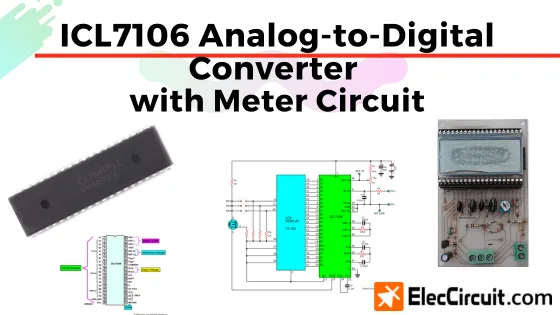
A few examples of usages for the ICL7106 include replacing the analog meter in circuits such as a frequency meter, temperature reader, moisture meter, light meter, and many more.
Even though precision may be lower than that of a store-bought multimeter, this circuit will still be much more precise than an analog meter. It would also have an LCD reading and a very high input impedance within its measurement ranges.
The ICL7106 3½ A/D Converter with LCD Driver
The ICL7106 is a low-power 3½-digit analog-to-digital converter together with an integrated display driver, a clock, and a reference. It can be connected directly and drive an LCD measurement reading display. The ICL7106 is often the choice for a single-chip digital meter solution.
Features
- Maximum zero drift of 1μV per °C
- Zero reading for 0V input within 10pV
- Noise level lower than 15μVp-p
- Usual input current of 1pA
- Power dissipation of less than 10mW
- Differential input and reference
- Can directly drive an LCD
- Integrated clock and reference
- Typical meter applications require only basic components
Pinouts
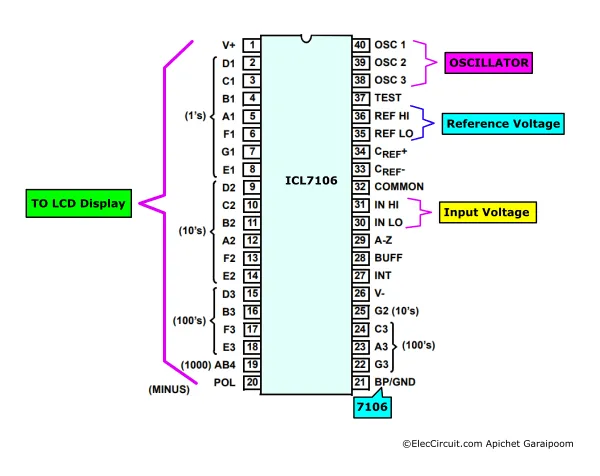
Pinouts of the ICL7106 A/D Converter
Datasheets
For more information about the ICL7106, see this chip manufacturer’s datasheet.
ICL7106 by Renesas Electronics (Intersil)
Digital Meter Circuit using the ICL7106
Our plan for this ICL7106 digital meter circuit is to use it to replace an analog display in circuits such as this frequency meter and moisture meter. Because, as mentioned above, it will have higher precision than the analog solutions.
Therefore, this circuit will only measure in the 0-200mV range. However, you could make a few changes to this circuit and increase the range to 0-2V as well. We will also show you other ways to widen the measurement range and increase the number of them.
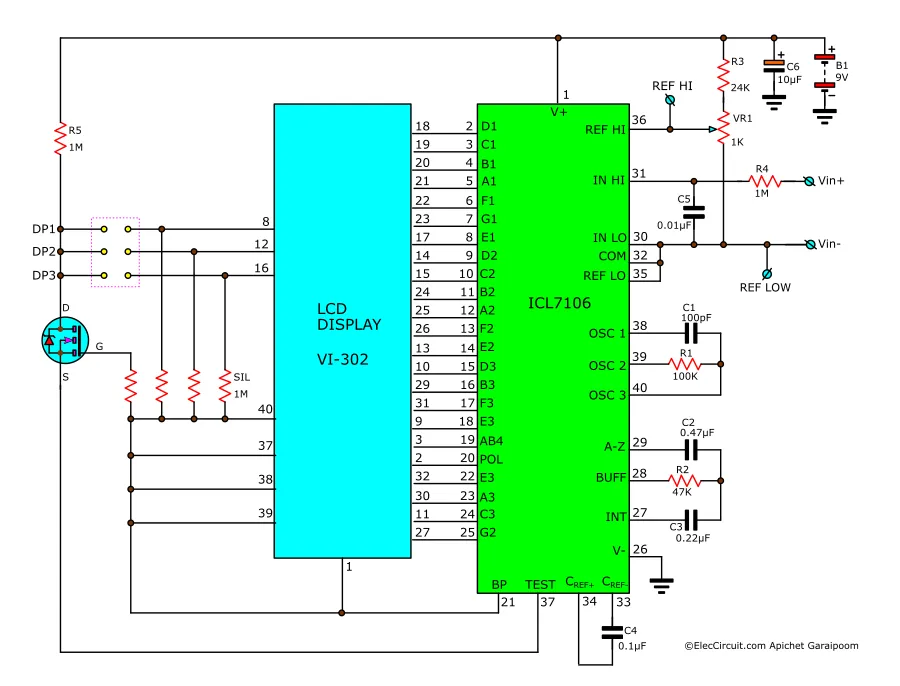
Digital Meter Circuit using the ICL7106
How it Works
How this circuit works is not very complicated since most of it is integrated within the ICL7106. R1 and C1 determine the internal oscillator frequency of the chip; in this circuit, we set it to 48kHz. R2 and C2 set the input voltage ranges. We use the 0-200mV range, so in this circuit R2 = 47kΩ and C1 = 0.47μF. However, for a 0-2V range, R2 = 470kΩ and C1 = 0.047μF.
Furthermore, we would also need to set the reference voltage with VR1. For a 0-200mV range, set it to 100mV; for a 0-2V range, set it to 1V. R4 limits the current flowing into the IC, protecting it from overcurrent and damage.
This chip can drive a liquid crystal display directly without the need for other components. However, an LCD cannot be driven with a DC voltage, so we would also need to connect a pulse signal from pin 21 to the COM of an LCD. Additionally, we left pins 8, 12, and 16 of the LCD as jumpers to determine the decimal placement in the display.
The image below shows the layout and pinout of the VI-302 LCD, which is the LCD that we are using. If you wish to learn more about this LCD, check out its datasheet here.
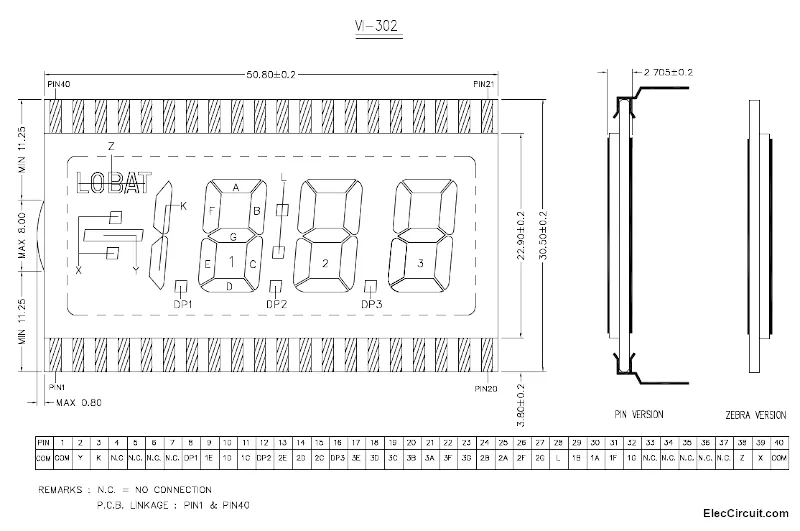
Pinout of VI-302 LCD
Using this Circuit
We built this prototype of the ICL7106 digital meter circuit, and after testing, it worked very well. We have tried replacing the analog meter with it; the reading is more accurate, and the number range displayed on the LCD is 0-199. This circuit helps improve the readability of a temperature or moisture meter by displaying the exact values on the LCD.
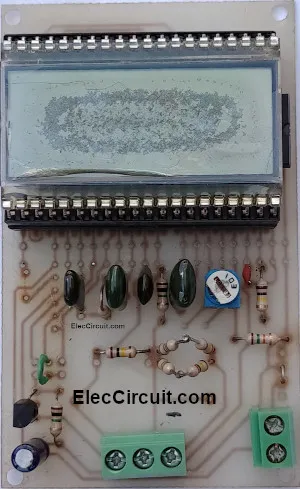
In this prototype circuit, we set the range to 0-200mV. So we use VR1 to set the reference voltage—read from REF HI and ground—to exactly 100mV.
Increasing the Measurement Ranges
To increase the measurement ranges, we would need to add resistors across the input of the circuit (Vin+ and Vin-). There are two ways of doing it, depending on the applications.
Increasing Voltage Ranges
This is a simple series resistor circuit together with a selector switch. Use a selector switch to choose how many resistors are in the series circuit and thus how much total voltage is across them.
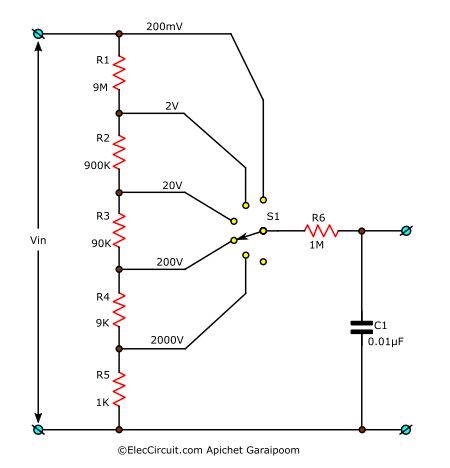
This circuit in particular provides our digital voltmeter circuit with a total of five ranges: 200mV, 2V, 20V, 200V, and 2,000V. In addition, you may need to parallel two or more resistors in this circuit to obtain some of the resistance values.
Convert to Digital Ammeter
Furthermore, we could also convert this digital meter circuit to be an ammeter circuit. Adding resistors—as shown below—results in an ammeter that could measure a total of five current ranges: 200μA, 2mA, 20mA, 200mA, and 2A.
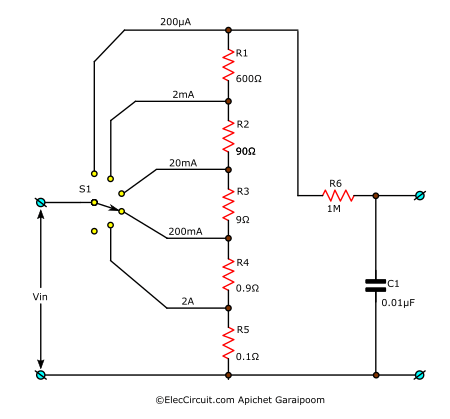
Conclusion
From our testing, the ICL7106 is quite effective and precise, similar to the ICL7107. It uses just a single 9V battery as a power source. The circuit also consumes very little power overall due to the LCD. The ICL7106 error rate is about 2-3% compared to the analog meter at around 10%, and its low input impedance allows it to measure very low currents. Anyhow, in our opinion, this chip is still quite expensive. In the future, we will find a better alternative for this chip.

In the ammeter circuit R1 should be 900 ohms not 600 ohms.
Thanks, my friend.
perfeito e interessante este projeto. aprendi muito e com detalhes. espero mais projetos como este.